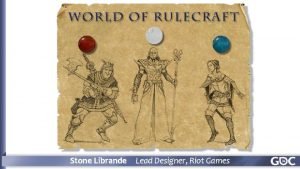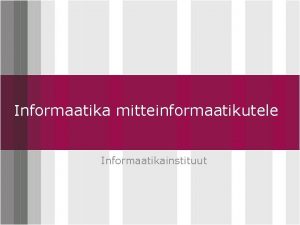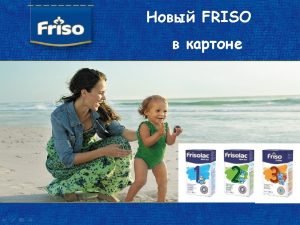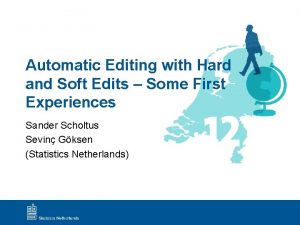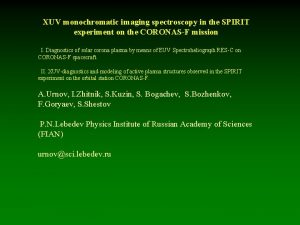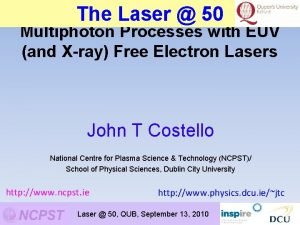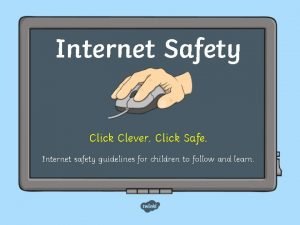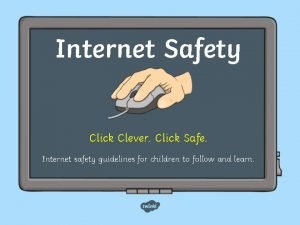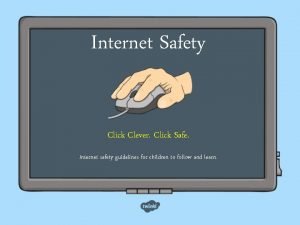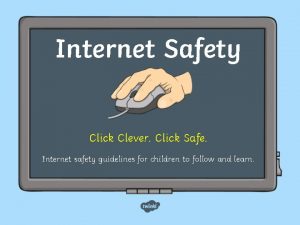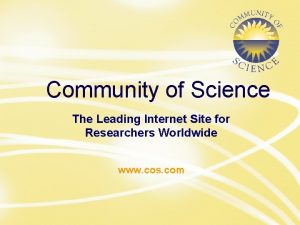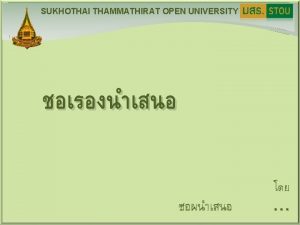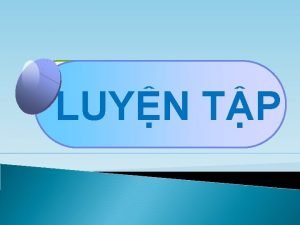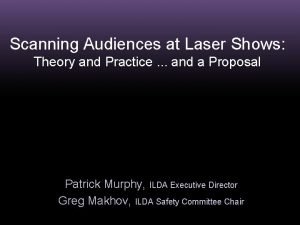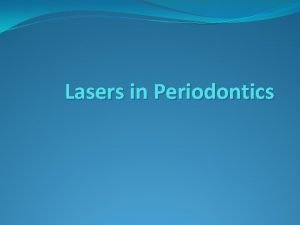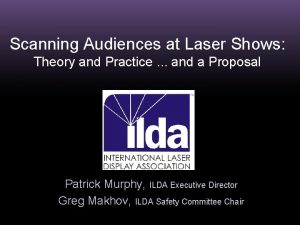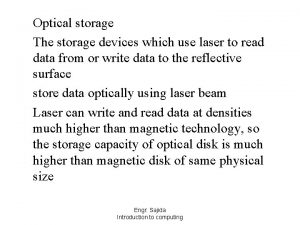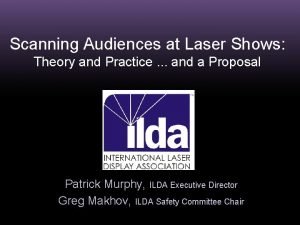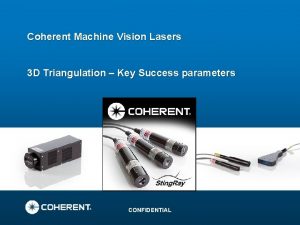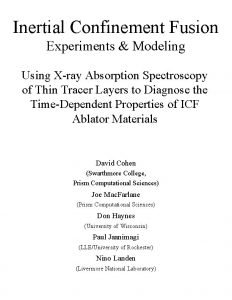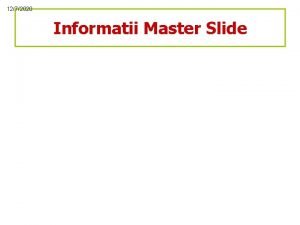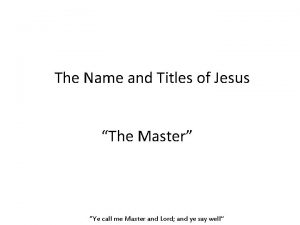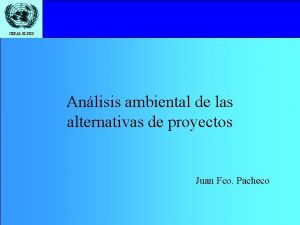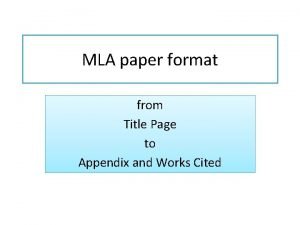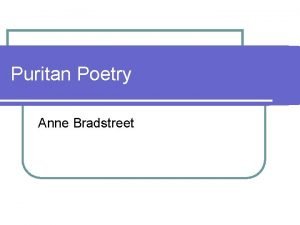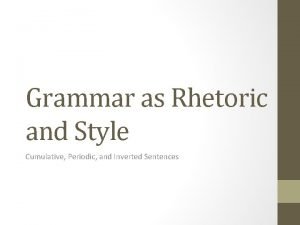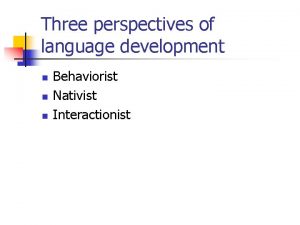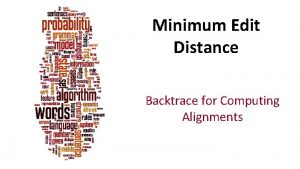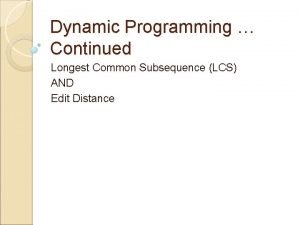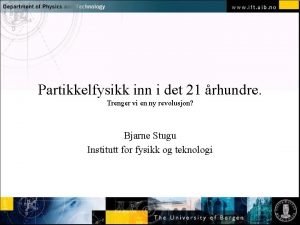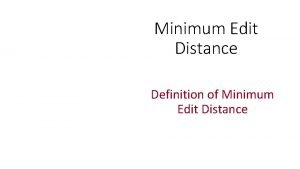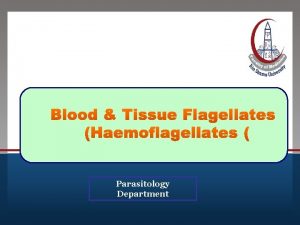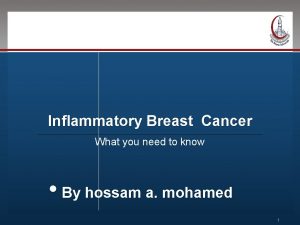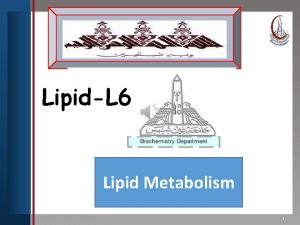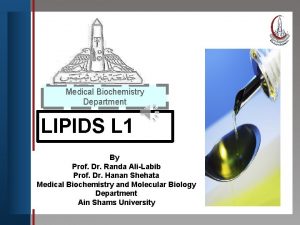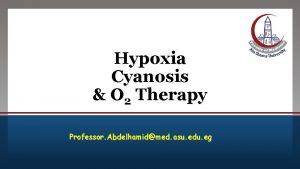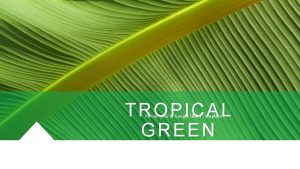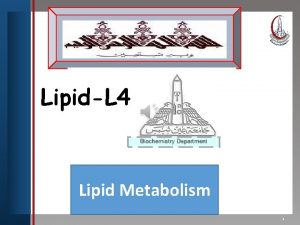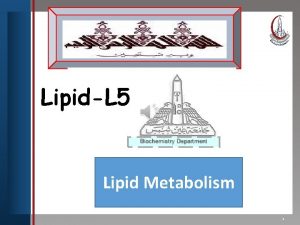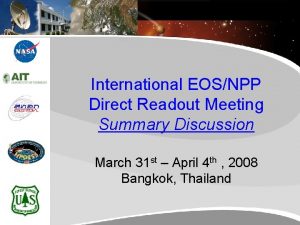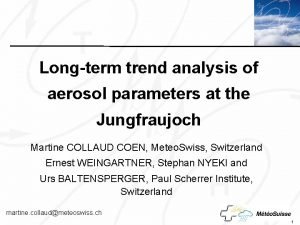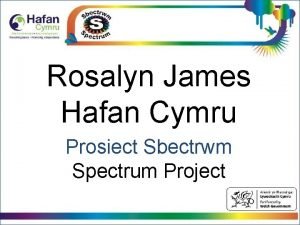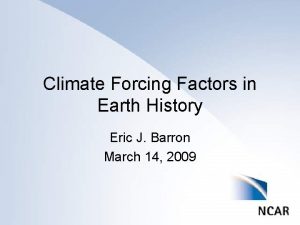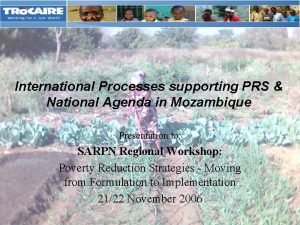Click to edit Master title style XUV Lasers






























![Dose Click to and edit radiation Master chemical title style yield Kerma [Gy]: Dose Dose Click to and edit radiation Master chemical title style yield Kerma [Gy]: Dose](https://slidetodoc.com/presentation_image/1ab906b0440f9c77284ab9e5c7188bf4/image-31.jpg)











- Slides: 42

Click to edit Master title style XUV Lasers in Radiation Biology Luděk Vyšín (vysin@fzu. cz) Department of Radiation and Chemical Physics Institute of Physics of the CAS Na Slovance 2, 182 21 Praha 8 Department of Nuclear Chemistry, FNSPE of the CTU Břehová 7, 115 19 Praha 1

Outline Click to edit Master title style • Introduction – motivation • Interaction of XUV and SXR with matter • Interaction of charged particles with matter • Experimental sources of XUV/SXR • Biological samples • Interaction of XUV/SXR with DNA • Dosimetry and Radiation chemical yield • Results • Future plans 2

Introduction Click to edit -Master motivation title style • Development of proton (ion) accelerators based on „short“ laser pulses (~ns) delivered to solid targets (Ti) for radiotherapy • Radiobiology of ultra-high dose rates UHDR (d. D/dt > 109 Gy s-1) • Application of the soft X-ray (SXR) a extreme UV (XUV) radiation to simulate the interaction effects of charged particles traversing a tissue. The so called „spur overlap“ effect can be studied using such experimental sources • To compare the effects of conventional (monochromatic) radiation sources to the effects of the experimental ones • Apply the standard techniques to study the effects in UHDR on a molecular level. Can be useful in a future medical applications (ELI Med) • Compact size of experimental sources allows experiments in ordinary laboratory environment 3

Outline Click to edit Master title style • Introduction – motivation • Interaction of XUV and SXR with matter • Interaction of charged particles with matter • Experimental sources of XUV/SXR • Biological samples • Interaction of XUV/SXR with DNA • Dosimetry and Radiation chemical yield • Results • Future plans 4

Interaction Click to editof. Master XUV and title. SXR stylewith matter Radiation very strongly absorbed. Dependent on elemental composition and density of the absorbing specie. Attenuation length ~ 1 – 10 nm Interaction exclusively due to the photoelectric effect followed by Auger electrons emission (low Z) H 2 O 5

Charged Click to edit particles Mastervs. title photons style (gamma) Penetration depth (dose–depth curve) Single field irradiation photons protons 4 field stereotactic irradiation photons protons 6

Laser Click to Driven edit Master Protontitle Acceleration style (LDPA) A 549 pulmonary adenocarcinoma γ-H 2 AX staining antibody Yogo, Jpn J Appl. Phys 50 (2011) 7

Outline Click to edit Master title style • Introduction – motivation • Interaction of XUV and SXR with matter • Interaction of charged particles with matter • Experimental sources of XUV/SXR • Biological samples • Interaction of XUV/SXR with DNA • Dosimetry and Radiation chemical yield • Results • Future plans 8

Interaction Click to editof. Master charged titleparticles style with matter Soft collisions: Perpendicular component can be represented by its Fourier transform: Spectrum may be viewed as a flux of photons with a range of energies with cutoff at: 9

Absorption Click to editof. Master Energytitle in H style 2 O and DNA Energy loss function 10

Track Click to Structure edit Master of the title Fast style Charged Particle Geant 4 track simulation - 100 p+ in air (30 cm track length) 30 Me. V 200 Me. V Track core: (excitations, ionizations) Penumbra: δ-electrons distance (ionizations) Effects of ionizations and excitations of high density at a timescale of nanoseconds can be simulated using XUV and SXR sources 11

Outline Click to edit Master title style • Introduction – motivation • Interaction of XUV and SXR with matter • Interaction of charged particles with matter • Experimental sources of XUV/SXR • Biological samples • Interaction of XUV/SXR with DNA • Dosimetry and Radiation chemical yield • Results • Future plans 12

Click to edit Master title Experimental sources ofstyle XUV/SXR Prague Asterix Laser System: Ar and Xe plasma emission (500 ps) Xe Ar

Click to edit Master title Experimental sources ofstyle XUV/SXR PALS (Prague Asterix Laser System) – SXR (250 – 1570 e. V) Gas puff target Xe/He plasma Ar/He plasma 14

Click to edit Master title Experimental sources ofstyle XUV/SXR PALS (Prague Asterix Laser System) – SXR (250 – 1570 e. V) Zn target – QSS (Ne-like zinc) Wavelength: 21. 2 nm (58. 5 e. V) 15

Experimental Click to edit Master sources title ofstyle XUV/SXR Extreme UV (XUV) capillary discharge laser (IOP CAS) Ne-like Ar 8+ capillary discharge laser (CDL) Laser emission by Z-pinch effect of Ar 8+ plasma (Pulsed source) Laser transition between 1 S 0(2 p 1/23 p 1/2)J=0 a 1 P 1(2 p 1/23 s 1/2)J=1 states S. Heinbuch et al. : Optics Express 13, 4050 (2006) 16

Experimental Click to edit Master sources title ofstyle XUV/SXR Extreme UV (XUV) capillary discharge laser (IOP CAS) XUV beam Output characteristics Wavelength Δλ/λ 46. 9 nm 8 x 10 -4 Pulse length 2 ns (FWHM) Pulse energy 1 μJ Rep. rate 12 Hz (3 Hz) 17

Experimental Click to edit Master sources title ofstyle XUV/SXR Source of soft X-ray radiation in “water window “ energy range (WAT) Nd: YAG Laser: 1024 nm, 0. 75 J, 4 ns, 10 Hz, rep. rate: 30 Hz He cell: Ar plasma emission: 4. 2 x 1014 photons/m 2 per pulse at sample position (in vacuum chamber) 18

Click to edit Master title style Radiation sources IOE - MUT: Ar plasma emission (5 ns) D. Adjei et al. : Rad Phys Chem 120, 17 (2016)

Outline Click to edit Master title style • Introduction – motivation • Interaction of XUV and SXR with matter • Interaction of charged particles with matter • Experimental sources of XUV/SXR • Biological samples • Interaction of XUV/SXR with DNA • Dosimetry and Radiation chemical yield • Results • Future plans 20

DNA Click Samples to edit Master title style Plasmid DNA: extracted circular nucleic acid molecule (4361 bp long) M = 2. 86× 106 Da AFM 60 Co © Egor Ukraintsev, Ph. D gamma (1. 25 Me. V) Stabilized by TE buffer (Tris. HCl: EDTA in different ratios) Dried in N 2 atmosphere 21

Outline Click to edit Master title style • Introduction – motivation • Interaction of XUV and SXR with matter • Interaction of charged particles with matter • Experimental sources of XUV/SXR • Biological samples • Interaction of XUV/SXR with DNA • Dosimetry and Radiation chemical yield • Results • Future plans 22

Interaction Click to editof. Master XUV/SXR title style with DNA Plasmid DNA: direct vs. indirect effect Adhikary A. , Electron spin resonance of radicals in irradiated DNA. (2014) 23

Interaction Click to editof. Master XUV/SXR title style with DNA damage pathway Adhikary A. , Electron spin resonance of radicals in irradiated DNA. (2014) 24

Absorption Click to editof. Master DNA intitle electromagnetic style spectrum Plasmid DNA: p. BR 322 (4361 bp) Optical constants: π → π* excitation of heterocycles of bases (4. 7 e. V až ~6. 5 e. V): T-T (T-C) dimers in far UV (<8 e. V) σ – excitations connected with sugar-phosphate backbone (> 7. 8 e. V) σ → σ* excitation of bases (13. 8 e. V) d. R + hv → d. R • leads to SSBs and DSBs (the yield of DSBs rise with the secondary electrons energy) 25

Interaction Click to editof. Master XUV/SXR title Radiation style with DNA Effects of XUV (46. 9 nm) on plasmid DNA breakage demonstrated: Nováková et al. : Phys. Rev. E 91 (4), 042718, 2015 SSB DSB SSB* 26

Interaction Click to editof. Master XUV/SXR title Radiation style with DNA Effects of XUV (46. 9 nm) on plasmid DNA demonstrated: Nováková et al. : Phys. Rev. E 91 (4), 042718, 2015 S C L 27

Interaction Click to editof. Master XUV/SXR title Radiation style with DNA Effects of XUV (46. 9 nm) on plasmid DNA demonstrated: Nováková et al. : Phys. Rev. E 91 (4), 042718, 2015 S C L 28

Detection Click to edit of Master Plasmidtitle DNA style Forms Agarose electrophoresis + Sybr. GREEN I www. yourgenome. org βSSB βDSB f S 0 29

Outline Click to edit Master title style • Introduction – motivation • Interaction of XUV and SXR with matter • Interaction of charged particles with matter • Experimental sources of XUV/SXR • Biological samples • Interaction of XUV/SXR with DNA • Dosimetry and Radiation chemical yield • Results • Future plans 30
![Dose Click to and edit radiation Master chemical title style yield Kerma Gy Dose Dose Click to and edit radiation Master chemical title style yield Kerma [Gy]: Dose](https://slidetodoc.com/presentation_image/1ab906b0440f9c77284ab9e5c7188bf4/image-31.jpg)
Dose Click to and edit radiation Master chemical title style yield Kerma [Gy]: Dose [Gy]: mass energy transfer coefficient [m 2/kg] energy fluence [J/m 2] surface density [kg/m 2] Radiation_ chemical yield: Radiation chemical yield G(X) is the ratio of n(X) and ε, where n(X) is the mean amount of matter of a specified nature by transfer of a mean amount of energy _X formed, destroyed or changed _ ε to matter. G(X) = n(X)/ε [mol/J] 31

SXR Click chemical to edit Master dosimetry title style Water radiolysis: 32

SXR Click chemical to edit Master dosimetry title style Water radiolysis: Courtesy of Václav Štěpán, Ph. D Geant 4: DNA simulation 33

SXR Click chemical to edit Master dosimetry title style Established fluorescent dosimetry systems: 34

SXR Click chemical to edit Master dosimetry title style Fricke dosimeter: 1 m. M Fe. SO 4, 1 m. M Na. Cl, 0. 8 N H 2 SO 4 Ionizing radiation interacting with water produces a range of ions, radicals and molecules: H OH H 2 O 2 H+ OH- e-aq ferrous Fe 2+ Fe 3+ ferric Molecular oxygen is needed and is a limiting factor The maximum absorbed dose that can be measured is about 400 Gy 35

SXR Click chemical to edit Master dosimetry title style ? G(Fe 3+) – Radiation chemical yield (molecules/100 e. V) 36

Outline Click to edit Master title style • Introduction – motivation • Interaction of XUV and SXR with matter • Interaction of charged particles with matter • Experimental sources of XUV/SXR • Biological samples • Interaction of XUV/SXR with DNA • Dosimetry and Radiation chemical yield • Results • Future plans 37

Results Click to edit Master title style Action cross sections for pulsed sources (500 ps – 5 ns) in comparison to synchrotron radiation 38

Results Click to edit Master title style G values for pulsed sources (500 ps – 5 ns) in comparison to synchrotron radiation 39

Outline Click to edit Master title style • Introduction – motivation • Interaction of XUV and SXR with matter • Interaction of charged particles with matter • Experimental sources of XUV/SXR • Biological samples • Interaction of XUV/SXR with DNA • Dosimetry and Radiation chemical yield • Results • Future plans 40

Future Click toplans edit Master title style • Femtosecond XUV/SXR laser (laser-plasma) sources would be beneficial in the study of the dose rate effect • Wider range of XUV photon energies • Apply theoretical modelling approach (fs time scale) • Use of mass spectrometry to determine the fragmented species (damaged bases) • Use of restriction enzymes to distinguish between the damage localized on sugar-phosphate backbone (strand breaks) and nucleobases (abasic sites) 41

Acknowledgements Click to edit Master title style Department of radiation and chemical physics IOP CAS Wojskowa Akademia Techniczna Przemyslaw Wachulak Andrzej Bartnik Henryk Fiedorowicz Daniel Adjei Mesfin Getachew Ayele Tomáš Burian Eva Nováková Martin Přeček Libor Juha Department of personal dosimetry, INP CAS PALS facility Marie Davídková Kateřina P. Brabcová Václav Štěpán Eduard Krouský Miroslav Krůs Department of nuclear chemistry, FNSPE – CTU Kateřina Tomanová Martin Vlk Václav Čuba Viliam Múčka Thank you for your attention 42
 Click to edit master title style
Click to edit master title style Click to edit master title style
Click to edit master title style Click to edit master title style
Click to edit master title style Click to edit master title style
Click to edit master title style Hard edits
Hard edits Xuv spectrometer
Xuv spectrometer Ait xuv
Ait xuv Click clever click safe
Click clever click safe Internet safety
Internet safety Cyber safety
Cyber safety Clever click
Clever click Master title style
Master title style Master title style
Master title style Click to add title
Click to add title Click to add title
Click to add title Click to add title
Click to add title Audience scanning laser
Audience scanning laser Types of lasers
Types of lasers Audience scanning lasers
Audience scanning lasers Characteristics of lasers
Characteristics of lasers It uses laser to read the data
It uses laser to read the data Audience scanning lasers
Audience scanning lasers Machine vision lasers
Machine vision lasers Inertia xray
Inertia xray What is a slide title master pair
What is a slide title master pair Daskolos
Daskolos Master title
Master title Title fly of a report
Title fly of a report Title title
Title title Apa does title page have page number
Apa does title page have page number Examples of appendices
Examples of appendices Top right corner of the page
Top right corner of the page Block lettering styles
Block lettering styles Inversion poem
Inversion poem What is formal style writing
What is formal style writing Cumulative sentence
Cumulative sentence Casual writing style
Casual writing style Referential vs expressive style
Referential vs expressive style Minimum edit distance backtrace
Minimum edit distance backtrace Kronos historical edit
Kronos historical edit Edit distance dynamic programming
Edit distance dynamic programming Hva betyr edit
Hva betyr edit Weighted minimum edit distance
Weighted minimum edit distance
